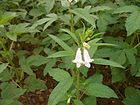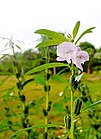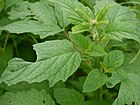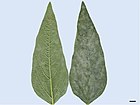Note: This is a project under development. The articles on this wiki are just being initiated and broadly incomplete. You can Help creating new pages.
Sesamum indicum - Sesame, Snehaphala
Sesame is a variable, erect, annual plant hat can grow from 1 - 3 metres tall. Plants can be branched or unbranched. The root system has a strongly tapering taproot up to 90cm long. The plant has been cultivated for its edible seed and oil since at least 2,000 BC, and is still widely grown in tropical and warm temperate zones
Contents
- 1 Uses
- 2 Parts Used
- 3 Chemical Composition
- 4 Common names
- 5 Properties
- 6 Habit
- 7 Identification
- 8 List of Ayurvedic medicine in which the herb is used
- 9 Where to get the saplings
- 10 Mode of Propagation
- 11 How to plant/cultivate
- 12 Commonly seen growing in areas
- 13 Photo Gallery
- 14 References
- 15 External Links
Uses
Infant cholera, Diarrhoea, Dysentery, Catarr, Bladder, kidneys problems, Liver problems, Premature hair loss, Greying of hair, Convalescence, Chronic dry constipation, Dental caries, Osteoporosis, Stiff joints, Dry cough, Haemorrhoids, Ulcer, Asthma, Coughs.
Parts Used
Chemical Composition
Common names
| Language | Common name |
|---|---|
| Kannada | achhellu, ellu, kari ellu |
| Hindi | tir |
| Malayalam | karuellu |
| Tamil | caralam, caralam, carali, caralicceti, cinekapalacceti |
| Telugu | gubbulu, guvvulu, |
| Marathi | NA |
| Gujarathi | NA |
| Punjabi | NA |
| Kashmiri | NA |
| Sanskrit | snehaphala, tila, tilaha, tilataila |
| English | gingelly, sesame |
Properties
Reference: Dravya - Substance, Rasa - Taste, Guna - Qualities, Veerya - Potency, Vipaka - Post-digesion effect, Karma - Pharmacological activity, Prabhava - Therepeutics.
Dravya
Rasa
Guna
Veerya
Vipaka
Karma
Prabhava
Habit
[[:Category:Habit - |]]
Identification
Leaf
| Kind | Shape | Feature |
|---|---|---|
| Paripinnate | Oblong | Leaf Arrangementis Alternate-spiral |
Flower
| Type | Size | Color and composition | Stamen | More information |
|---|---|---|---|---|
| Unisexual | 2-4cm long | pink | Flowering throughout the year and In terminal and/or axillary pseudoracemes |
Fruit
| Type | Size | Mass | Appearance | Seeds | More information |
|---|---|---|---|---|---|
| oblong pod | Thinly septate, pilose, wrinkled | seeds upto 5 | Fruiting throughout the year |
Other features
List of Ayurvedic medicine in which the herb is used
Where to get the saplings
Mode of Propagation
How to plant/cultivate
Sesame can be grown from the warm temperate zone to the tropics, so long as there is a growing season of at least 5 months. In the tropics it can be grown at elevations up to 1,500 metres.[3]
Commonly seen growing in areas
tropical region, plain region, along roadsides, along waste lands.
Photo Gallery
References
- ↑ ["Chemistry"]
- ↑ [ "Morphology"]
- ↑ "Cultivation detail"
External Links
- Ayurvedic Herbs known to be helpful to treat Infant cholera
- Ayurvedic Herbs known to be helpful to treat Diarrhoea
- Ayurvedic Herbs known to be helpful to treat Dysentery
- Ayurvedic Herbs known to be helpful to treat Catarr
- Ayurvedic Herbs known to be helpful to treat Bladder
- Ayurvedic Herbs known to be helpful to treat kidneys problems
- Ayurvedic Herbs known to be helpful to treat Liver problems
- Ayurvedic Herbs known to be helpful to treat Premature hair loss
- Ayurvedic Herbs known to be helpful to treat Greying of hair
- Ayurvedic Herbs known to be helpful to treat Convalescence
- Ayurvedic Herbs known to be helpful to treat Chronic dry constipation
- Ayurvedic Herbs known to be helpful to treat Dental caries
- Ayurvedic Herbs known to be helpful to treat Osteoporosis
- Ayurvedic Herbs known to be helpful to treat Stiff joints
- Ayurvedic Herbs known to be helpful to treat Dry cough
- Ayurvedic Herbs known to be helpful to treat Haemorrhoids
- Ayurvedic Herbs known to be helpful to treat Ulcer
- Ayurvedic Herbs known to be helpful to treat Asthma
- Ayurvedic Herbs known to be helpful to treat Coughs
- Herbs with Seeds used in medicine
- Herbs with leaves used in medicine
- Herbs with common name in Kannada
- Herbs with common name in Hindi
- Herbs with common name in Malayalam
- Herbs with common name in Tamil
- Herbs with common name in Telugu
- Herbs with common name in Sanskrit
- Herbs with common name in English
- Habit -
- Index of Plants which can be propagated by Seeds
- Herbs that are commonly seen in the region of tropical region
- Herbs that are commonly seen in the region of plain region
- Herbs that are commonly seen in the region of along roadsides
- Herbs that are commonly seen in the region of along waste lands
- Herbs









